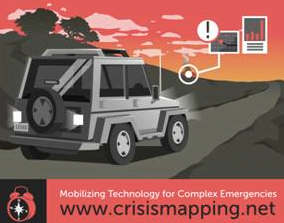Ed note: The report Disaster Relief 2.0: The Future of Information Sharing in Humanitarian Emergencies analyzes how the humanitarian community and the emerging volunteer and technical communities worked together in the aftermath of the 2010 earthquake in Haiti, and recommends ways to improve coordination between these two groups in future emergencies. The UN Office for the Coordination of Humanitarian Affairs (OCHA), together with the United Nations Foundation and Vodafone Foundation Technology Partnership, commissioned the report, which was researched and written by a team at the Harvard Humanitarian Initiative.
The Disaster Relief 2.0 Blog Series provides a public forum for people from both the humanitarian and volunteer and technical communities to discuss ideas in this report and the future of disaster relief.
You can follow conversations about the report on Twitter using the hashtag #DisasterTech and on the UN Foundation’s Facebook page. Readers can submit questions to the report’s authors through those channels; a transcript with answers to select questions will be published on UN Dispatch on April 11, 2011.
What the UN could not have done without the Volunteer Technical Community
By Andrej Verity
The office that I work for – UN OCHA – recently took a big leap forward by engaging the VTCs for responding to the Libyan and Japan crises. We dove into a collaboration with the VTCs in a first effort to try to make the responses better. However, the most common questions I have received are “So what?” and “What was the impact?”.
When the Libya crisis broke out, I asked permission in OCHA to call a meeting between OCHA and many of the VTCs. In the first teleconference, the Stand By Task Force (SBTF), an organized group of 150+ volunteers skilled in online Crisis Mapping, was activated to map out the social media and traditional media reports from within the country – the result: LibyaCrisisMap.net. So what? Well, given that the UN had virtually no access to the country, we now had situational awareness. How much is that worth to a agency planning its response? Could you plan with virtually no information? I know the site was being used by agencies such as the World Food Programme, the UN High Commissioner for Refugees (UNCHR) the Red Cross,and USAID to perform certain types of analysis and to aid in their planning.
In addition, we requested the SBTF to help with collection of Who’s-doing-What-Where (3W) information and baseline indicators values. Within 48 hours, we had 100+ activities collected and compiled. Let’s put that in perspective: the same amount of data took about 4 weeks in the Philippines, 2 weeks in Haiti, and 2 weeks in Pakistan to be made avalable. See an improvement? Combining this data with Libya Crisis Map, we can now overlay the reported health needs with the actual health response – gap analysis. In regards to the baseline indicator compilation task, it had never been done before so I cannot even compare it to past experience. More future potential.
Crisis Commons compiled data sources under the framework of the Common Operational Datasets (CODs) for Japan. Within minutes of our request, they had a Japan Data Profile wiki online. They automated Google searches as well as Google Translate to search Japanese sites. I understand that the compiled data was used by MapAction responders (supporting UNDAC), NetHope partners, and others providing relief. The comprehensive search and compilation would not have happened without the VTCs.
 This was our first step and we have learned many lessons. In combination with these lessons learned and the recommendation from the Disaster Relief 2.0 report, I believe that we are just starting to find our footing in the collaboration space with the VTCs. I am hopeful that we have found a concrete way forward. I am excited. OCHA is planning a lessons-learned session with the VTCs in June, but the question is: “will we have time to stop and review?”. I am already getting emails from partners such as Open Street Map and Internews asking when we will be starting a Crisis Map for Cote D’Ivoire. We have taken one step, but might have to run sooner than we thought.
This was our first step and we have learned many lessons. In combination with these lessons learned and the recommendation from the Disaster Relief 2.0 report, I believe that we are just starting to find our footing in the collaboration space with the VTCs. I am hopeful that we have found a concrete way forward. I am excited. OCHA is planning a lessons-learned session with the VTCs in June, but the question is: “will we have time to stop and review?”. I am already getting emails from partners such as Open Street Map and Internews asking when we will be starting a Crisis Map for Cote D’Ivoire. We have taken one step, but might have to run sooner than we thought.
Andrej has been an Information Management Officer in UN OCHA for the past 7 years. He responded to three recent major emergencies in less than one year: typhoons in the Philippines, earthquake in Haiti and floods in Pakistan. In two instances, he was the lead OCHA Information Management Officer on the ground. Although a strong advocate for collaboration with the V&TCs, he is also a realist and knows that a lot of work is required to reach the true potential of such collaboration.
